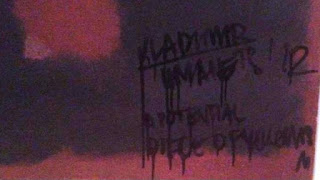 |
| Exhibition leaflet signed by Quentin Blake |
I was lucky enough to attend the private view of children's illustrator Quentin Blakes selling exhibition, 'Octoquentinicious,' at Chris Beetles gallery the weekend before last. Not only did the exhibition feature over 100 signed drawings and watercolours by Quentin, but he himself was there!
Best known for his 15 year partnership with Roald Dahl and his unforgettable illustrations for Matilda, James and the Giant Peach, The Twits, The Witches and The BFG - many of which can be seen in the exhibition.
I hadn't however appreciated quite how many other books he has illustrated, sitting on the cornice above the pictures were lots of other books he has worked on. The exhibition includes 75 new and unseen works, many created specifically for this exhibition, the majority of which sold before it even opened. Prices range from £250 - £5,000.
I did feel a little foolish having queued up for his autograph and declared I was his biggest fan, when I asked who his favourite character was that he had drawn over the years. Presuming it would be a Roald Dahl character I knew well he responded 'Clown,' to which I drew a total blank, never heard of that one.
Music was provided by the Jelly Roller and there were several sweet mountains...













